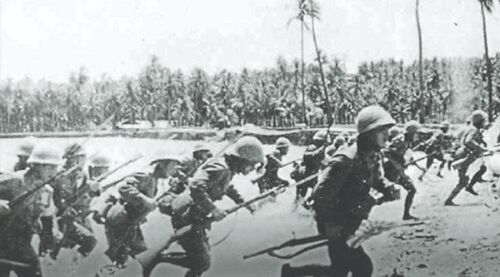Tragedy of Homfreyganj
Though obscured by the passage of time, the massacre at Homfreyganj by occupying Japanese forces during WW2 must, nevertheless, be addressed in order to bring closure

Every year, like elsewhere in the country, Martyr's day is observed on January 30 throughout the country in memory of Gandhiji who was assassinated on this day in 1948. In Andaman & Nicobar Islands this day has an added significance as it was on this day in 1944, that the Japanese Imperial Army had executed 44 prominent citizens of the Islands and had buried them in a mass grave in Homfreyganj, located 16 km away from Port Blair
Atrocities by the Japanese armed forces on the civilian population of territories occupied by them during the Second World War such as in Nanjing, Manila, Singapore etc., are well documented. However, the reign of terror that the Japanese forces inflicted on the peace-loving and simple people of Andaman & Nicobar Islands who had initially welcomed them as liberators is perhaps not that well known.
During the Second World War, the Andaman & Nicobar Islands fell to the Japanese forces on March 23, 1942. The Japanese forces had already occupied Singapore, Rangoon and most of Southeast Asia. Most members of the British Colonial establishment in Andaman & Nicobar Islands had already been evacuated to the mainland before the Japanese arrived. However, the local people of the Islands were not evacuated to the mainland and were left to the mercy of the invading Japanese forces.
The islanders hailed the Japanese forces as their liberators from British Rule. A peace committee composed of prominent islanders was constituted with the objective of helping the Japanese in administering the Islands. In April 1942, the Andaman Branch of the Indian Independence League (IIL) was formed by the islanders. Likewise, the Andaman Branch of the Indian National Army (INA) was formed in June 1942.
However, after the initial bonhomie, the relationship between the Islanders and the Japanese forces soon started deteriorating. Although the British had been driven out of the Islands, they continued to heavily bombard the harbours, ships and other strategic assets of the Japanese forces on the Islands. causing heavy damage.
The Japanese began suspecting the islanders of providing intelligence to the British and unleashed a reign of terror in the Islands which alienated them from the local population. Many members of the Indian Independence League were arrested by the Japanese forces on trumped-up charges of spying for the British. Seven members of the India Independence League were arrested and shot dead at the Dignabad shore on March 30, 1943. Subsequently, other members were arrested on similar false charges. Many, including Dr Dewan Singh, President of the India Independence League succumbed to the injuries caused by tortures inflicted upon them by the Japanese.
In the early hours of January 30, 1944, 44 members of the Indian Independence League were taken out from the Cellular Jail where they had been imprisoned and transported by trucks to Homfreyganj. Here, they were shot dead by a Japanese firing squad in batches of five. Some were also bayoneted. Their bodies were then buried in a mass grave. Eye witness accounts recall that the victims bravely met their end and kept chanting patriotic slogans.
It was only 35 years after this massacre that in 1979, that a memorial to the martyrs of Homfreyganj was constructed by a committee consisting mainly of descendants of the martyrs. The memorial has slabs bearing the names of the martyrs. On January 30 every year, the Homfreygunj Martyrs Memorial Committee conducts an interfaith memorial service.
During my two tenures in Andaman & Nicobar Islands, I was able to meet a number of islanders who provided me firsthand accounts of the crimes committed by the Japanese forces during their occupation of the Islands.
I have always wondered about what went wrong in the relationship between the Japanese forces and the local population of the Islands and what caused the Japanese to unleash their reign of terror on the very people who had welcomed them.
Why did the Japanese suspect the members of the India Independence League to be spying for the British when in fact they were completely committed to work for India's freedom? Who were the real spies?
The needle of suspicion falls upon the small section of the islanders and on the personnel of the British Indian Military Police whose Commandant, MacCarthy had planted his spies amongst the islanders. Unfortunately, the Japanese could not find the people who were actually spying for the British.
Why were the Indians who collaborated first with the British in the pre-war days and then with the Japanese during the war in the crimes against the islanders never brought to book? Such war crimes trials were commonplace in Europe and Asia after the war.
Also, unlike elsewhere in the other occupied territories, the victims of the Japanese atrocities in the Islands or their descendants did not receive any monetary compensation.
With the passage of time, memories of the horrors of the Japanese occupation of the Islands are receding. The new generation of tourists who throng the Islands are oblivious of these tragic events. Very few visit the memorial at Homfreyganj which is located just a bit off the road to the popular tourist spot of Wandoor.
However, bringing closure to this tragic chapter in our history is necessary. Maybe a statement of apology or regret by the present Japanese Government to the people of Andaman & Nicobar Islands may help in healing the wounds
The writer is the former-Chief Secretary, Andaman & Nicobar Administration. Views expressed are personal



